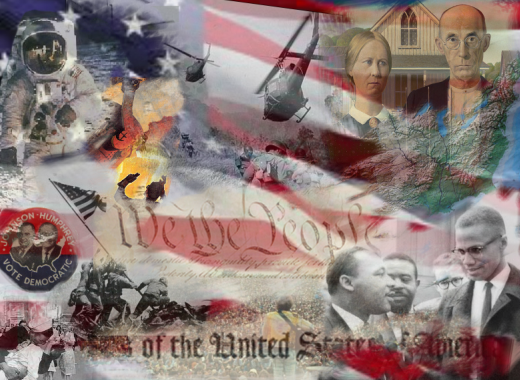

America's History is as rich and diverse as the people who make up its citizenry today. It is often studied or divided in half with the American Civil War as its center or cut-off point. The second half of U. S. history is often seen as starting with the Reconstruction to today. In the era following the war, legal and voting rights were extended to freed slaves. The national government emerged much stronger and gained explicit duty to protect individual rights. However, when white southern Democrats regained their political power in the South in 1877, often by paramilitary suppression of voting, they passed Jim Crow laws to maintain white supremacy, as well as new state constitutions that legalized discrimination based on race and prevented most African Americans from participating in public life.
The United States became the world's leading industrial power at the turn of the 20th century, due to an outburst of entrepreneurship and industrialization and the arrival of millions of immigrant workers and farmers. A national railroad network was completed and large-scale mines and factories were established. Mass dissatisfaction with corruption, inefficiency, and traditional politics stimulated the Progressive movement, from the 1890s to the 1920s, leading to reforms, including the federal income tax, direct election of Senators, granting of citizenship to many indigenous people, alcohol prohibition, and women's suffrage. Initially neutral during World War I, the United States declared war on Germany in 1917 and funded the Allied victory the following year. After the prosperous Roaring Twenties, the Wall Street Crash of 1929 marked the onset of the decade-long worldwide Great Depression. President Franklin D. Roosevelt implemented his New Deal programs, including relief for the unemployed, support for farmers, social security, and a minimum wage. The New Deal defined modern American liberalism.[1] Following the Japanese attack on Pearl Harbor, the United States entered World War II and financed the Allied war effort, and helped defeat Nazi Germany and Fascist Italy in the European theater. Its involvement culminated in using newly American-invented nuclear weapons on Hiroshima and Nagasaki to defeat Imperial Japan in the Pacific War.
The United States and the Soviet Union emerged as rival superpowers in the aftermath of World War II. During the Cold War, the two countries confronted each other indirectly in the arms race, the Space Race, propaganda campaigns, and localized wars against communist expansion. In the 1960s, in large part due to the strength of the civil rights movement, another wave of social reforms was enacted which enforced the constitutional rights of voting and freedom of movement to African Americans. The Cold War ended when the Soviet Union was officially dissolved, leaving the United States as the world's sole superpower. Foreign policy after the Cold War has often focused on many modern conflicts in the Middle East, especially in response to the September 11 attacks. Early in the 21st century, the United States experienced the Great Recession and the COVID-19 pandemic, which had a negative effect on the local economy.
The purpose of this guide is to provide you the researcher the ability to do research and study what many see as the second half of America's History. You will be able to search the library catalog and access our databases and journals all from within this course guide. This guide also provides you with a list of primary source websites on this particular era in American History, along with important information regarding library services and departments that may prove useful to you while you are doing research.
Sincerely,
Lawrence Mello, M.A., M.L.S.
Librarian Liaison to the FAU History Department.
Spring 2024 Semester Hours (Boca Raton):
See our library hours for all campuses at the link above, including any changes to hours during the semester.
Florida Atlantic University Libraries
777 Glades Road
Boca Raton, FL 33431
(561) 297-6911
